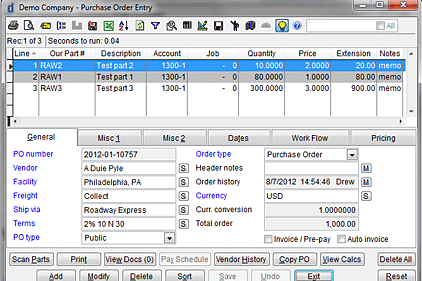TECH FLASH
New ERP system improves processor’s operations
When an ERP system needs to be reprogrammed to keep up, a new system can save money in the long run

|
| Modern ERP systems integrate purchase orders with inventory and track and trace. Source: Deacom. |
Ellis Huntsinger founded Huntsinger Farms, Inc. and its subsidiary Silver Spring Foods, Inc. (SSF) in 1929 when he started growing horseradish and other vegetable crops on a few acres of land near a fresh water spring south of Eau Claire, WI. Huntsinger Farms now grows horseradish in a five- to seven-year rotation with corn, soybeans, snap beans and other forage crops on over 9,000 acres of prime Wisconsin and Minnesota farmland. Silver Spring horseradish is a well-known retail brand in the US.
The world has changed a lot since 1929, and so has the way Silver Spring Foods runs its business. For instance, SSF recognized its enterprise resource management (ERP) system couldn’t handle its current business requirements and would be unable to evolve as the company continued to grow.
While the existing system was initially presented to SSF as an ERP module designed for the food manufacturing industry, the processor quickly realized the software required custom programming for functionality, which was excessively expensive and complicated. The system was slow and inflexible, and complex procedures were required to accomplish basic, everyday tasks. The standard built-in functionalities were minimal, and investments in additional functionality, such as internal reporting, were required to keep the business running.
SSF evaluated its needs and requirements. The ability to support complex pricing structures, a solid and efficient MRP module, and the ability to tie into third-party SQL-based manufacturing control systems were priorities in a new system. Additionally, SSF was looking for a system that:
►Ties together customer service, accounting, manufacturing, purchasing and shipping within a single tool;
►Has strong data mining and reporting functionality;
►Is configurable without customization;
►Has strong, sustainable technical support capabilities;
►Allows the processor to pre-define and maintain its annual ERP budget.
After comprehensive research, SSF narrowed the prospective vendor list to six possible choices.
Deacom ERP, which requires no customization, stood out as the only single solution presented. “Deacom promotes its system as being configurable, but the fact is Deacom will not introduce customized programming into the system,” says Noah Wallace, Silver Spring Foods CIO. “Deacom was the only system we saw that met all of our requirements without needing to be customized. As a result of this, Deacom was able to provide us with a not-to-exceed implementation quote, which no other competitor was even willing to discuss.”
As with any IT implementation, there were a number of different challenges regarding the mapping of previous business processes to the system. “At the time of the review and implementation, we were accustomed to a Warehouse Management System [WMS] that offered a table-based location system,” says Wallace. “We had to accept what we perceived as a shortcoming of the system in order to move forward. It didn’t take us long running Deacom to realize that the table-based location system was not necessary to our process. Deacom challenged us to think differently about our business process. [The supplier] did not simply do as we asked; it reviewed our requests and challenged them where necessary. That process made us a stronger company.”
Due to the previous multiple system setup, data conversion proved to be the most difficult part of the implementation, requiring Deacom and SSF to spend nearly six months mapping out the old ERP data structure. “The data conversion task was far more complicated than both parties anticipated, but Deacom stuck to its original quote for the project, and that meant a lot to our business,” says Wallace. “The day we went live, there were zero missed production orders out of over 6,000 and one delayed shipment, which we believe to be user-error, out of over 3,300. Deacom put a team on-site with us and was able to resolve any issues on the spot.”
SSF now has instant, real-time access to every facet of its business, which greatly improves the management team’s ability to make decisions based on timely and accurate information. Additionally, SSF has seen a significant improvement in inventory control, purchasing through MRP, scheduling and production. The processor also has seen a reduction in dollars lost due to material consumption issues that have been resolved due to greater visibility. SSF now runs a tighter inventory system because the MRP system allows the producer to fine-tune material purchases to match current production needs along with forecasted sales and production schedules. “Tighter inventory and reduced material loss all translate into lower costs. Lower costs allow us to quote new products competitively. That yields real dollars in increased sales,” states Wallace.
For more information, Stephanie Eaves; 610-971-2278, ext. 15; seaves@deacom.com
Looking for a reprint of this article?
From high-res PDFs to custom plaques, order your copy today!





